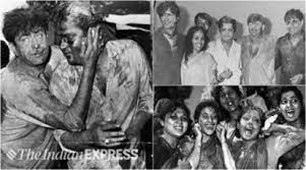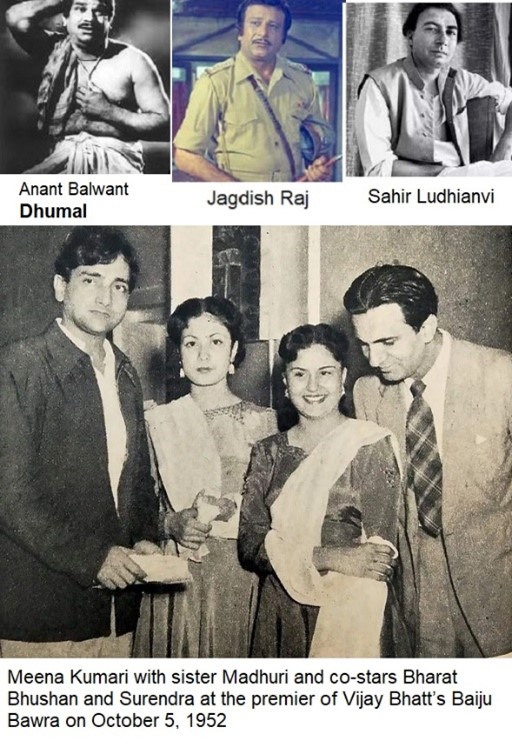Welcome to April 2024 edition of XIIth Volume of Carnival of Blogs on Golden Era of Hindi Film Music.
Recent celebrations to celebrate birth centenary of Mohammad Rafi (B: Dec 24, 1924 | D: Jul 31, 1980).
In the fourth show, on 24th April 2024, singers and musicians attempt to recreate Immortal Rafi … Immortal Duets
Here is one of the most elaborate April Fool pranks played by a film magazine in the 90s: Anupam Kher on a magazine cover as Sridevi’s sister.

Presently we move on to our section on tributes and celebrations for the month –
Rafi sings for Composers from Bengal – Anil Biswas, Salil Chowdhury and Hemant Kumar were covered in Part 1, S D Burman in Part 2 and R D Burman in Part 3 and now Part 4 focuses on a few well known, a few lesser known or forgotten composers from the 40s and the 50s mainly..
An Actress Par Excellence – There was more to Meena Kumari than being ‘Tragedy Queen’. Anuradha Warrier revisits the incomparable actor’s films that showcase her incredible range and immeasurable talent
The Masters: Shakeel Badayuni is a tribute to one of the finest romantic poets who worked in Hindi cinema on his 54th anniversary.
The Sculptors of Film Songs (14): Four Shades of the Dusk of the Series covers Bhanu Gupta, Homi Mullan, Kishor Sodha and Ranjit Gazmer in the concluding article of the series on SoY. The previous Arrangers and Musicians covered in the series are Sebastian D’ Souza, Anthony Gonsalves, Enoch Daniels, Kishore Desai Manohari Singh, S Hazara Singh, V Balsara, Ramlal , Dattaram, Van Shipley, Goody Seerwai ,“The Lords” and Ramprasad Sharma and Sons.
Wooden/Temple Block Songs – The wooden/Chinese temple blocks are percussion instruments without a membrane. According to music lover, musicologist, historian and archivist Kushal Gopalka, the earliest use of non-traditional percussion was made in Jawani Ki Reet (1939) by R.C.Boral, when he used wooden blocks for the song Chale pawan harsoo
Dilip Naik, the Hindi film industry musician you had heard even before you heard of him – Rudradeep Bhattacharjee – Dilip Naik made his debut as a session musician on the songs Chheda Mere Dil Ne and Gori Zara Hans De Tu from the Dev Anand-Sadhana starrer Asli Naqli (1962). In both these songs, Naik was part of a trio of acoustic guitarists in an orchestra consisting of more than 60 musicians. He had so far only played in front of a live audience; this was his introduction to the anonymous nature of a session musician’s work.

April 2024 episode of IXth volume of Fading Memories, Unforgettable Songs takes up Hasrat Jaipuri – Beyond Shankar Jaikishan: 1961 – Part 2. Till now, we have covered –
The songs from 1950 to 1953 in 2017,
The songs from 1953 to 1955. In 2018
The songs from 1956 -1957 in 2019,
The songs for 1958 in 2020,
The songs for 1959 in 2021,
The songs for 1960 in 2022, and.
The songs for 1961 Part I in 2023
Celebrating cinema through pictures:

We now move on to posts on other subjects –
How Ameen Sayani’s Binaca Geetmala took film songs to listeners in Jhumri Talaiya and beyond – Isabel Huacuja Alonso – For decades, Anil Bhargava, a devoted listener and chronicler of the programme, meticulously recorded the song competition’s results as well as any changes that the programme underwent. Bhargava began in his early teens, continued the work of his father, who recorded Geetmala’s earliest rankings. Based on these handwritten diaries, he published, Binaca Geetmala ka surila safar (Binaca’s melodious journey). This book is one of the finest resources about Geetmala available.

Book Review: DIRECTOR’S CHAIR: Hindi Cinema’s Golden Age by Manek Premchand

ISBN: 978-81-956660-8-9; Pages: 571
Price (Paperback on Amazon): ₹750
The Teller of Middle-Class Tales – Basu Chatterjee is the subject of National Award-winning author, Anirudha Bhattacharjee’s latest book, Basu Chatterjee and Middle-of-the-Road Cinema.

Subsequent to, Characters with Books: In English-language cinema, Hindi film characters with books, Part 2 is a sequel to a post about characters in Hindi cinema shown with book. The article narrates screenshots of Hindi film characters with books; and not just characters with books in the background.

In her latest book ‘Amitabh Bachchan as the Other’, film critic and author Shoma A Chatterji contends that beyond Amitabh Bachchan’s persistent ‘angry young man’ label, his cinematic prowess defies stereotypes, aligning him more closely with the intriguing concept of ‘The Other.’

The Hindi 𝘎𝘢𝘢𝘯𝘦 typically are not the songs that Vividh Bharati or ‘old’ time Radio Ceylon would play; these are the songs that has fast rhythm and random words thrown in, in the name of lyrics are Hindi gaane for the GenX.
Yeh Jeevan Hai: Songs on Life and Its Myriad Hues – NS Rajan explores how diversely our poets and lyricists have treated the subject of jeevan or life in all its moods and expressions in Hindi film songs.
Hindi film qawwalis – Part I presented the qawwalis from ’40s to ’50,Part II those from’60s. Now, Part III covers from the 70s and the 80s and now, the Part IV covers qawwalis from 90s and beyond.
In continuation to our tradition of ending the post with a few songs of Mohammad Rafi, this year being the celebration of Mohammad Rafi birth centenary, we will take up what others have said about him:
-
- Thirty years on, Mohd Rafi remains a favorite – Shammi Kapoor and others
I look forward to your inputs to enrich the contents of Carnival of Blogs on Golden Era of Hindi Film Music.
Disclaimer: This monthly series of posts is my best-effort-based compilation of posts on Hindi film songs that I normally visit regularly. As I record my sincere thanks to all the original creators of these posts, any other posts that I have nor covered herein shows my lack of awareness of existence of such posts and is by no means any disrespect to their work. The copyrights to the posts, images and video clips remain the properties of the original creators.



 by Shoma A Chatterji, unearths how the ‘working woman’ has been presented in films directed by women. The book is divided into three parts. Part I, which serves as a general introduction to the theme. Part II and Part III of the book analyses nine significant films made by women directors where the author combines scholarly research and critical acumen to contextualize individual directors and the complexity of separating the feminine from the professional.
by Shoma A Chatterji, unearths how the ‘working woman’ has been presented in films directed by women. The book is divided into three parts. Part I, which serves as a general introduction to the theme. Part II and Part III of the book analyses nine significant films made by women directors where the author combines scholarly research and critical acumen to contextualize individual directors and the complexity of separating the feminine from the professional. We also pay our respects to
We also pay our respects to 
 contains 20 sets of same name artists. The
contains 20 sets of same name artists. The 

